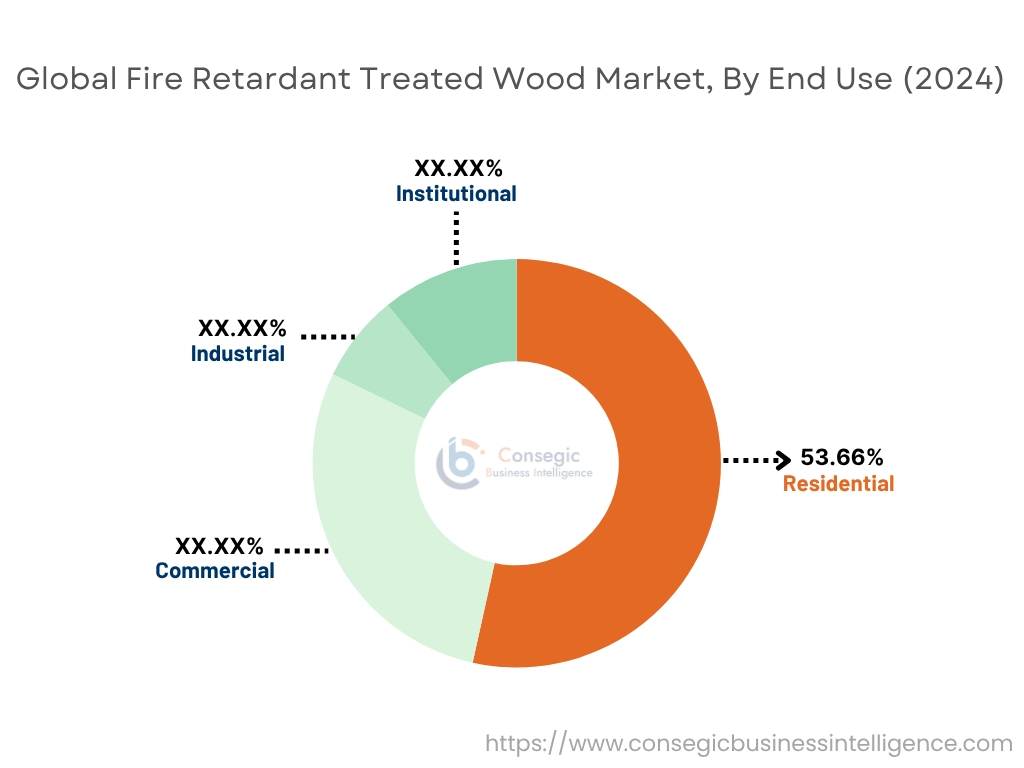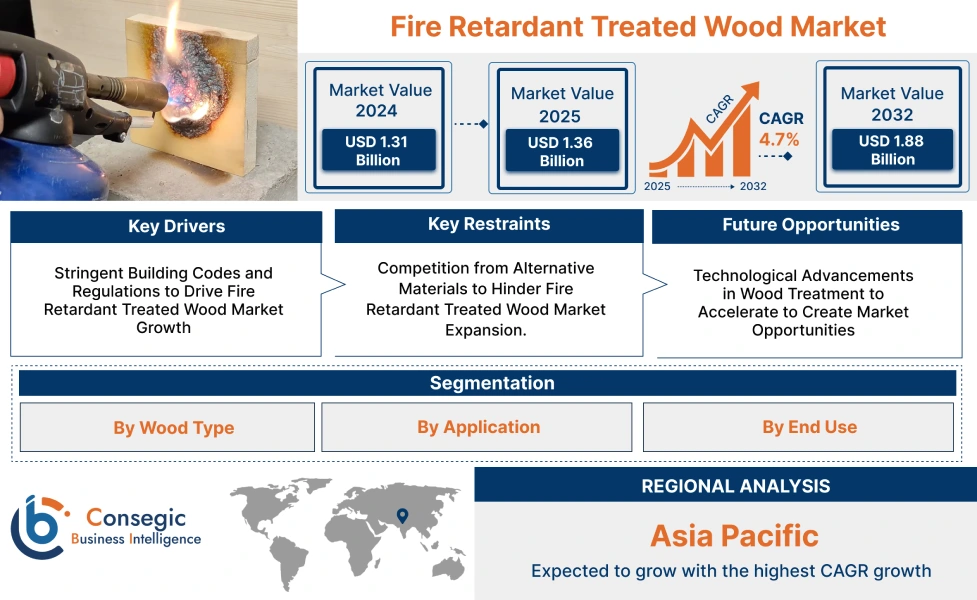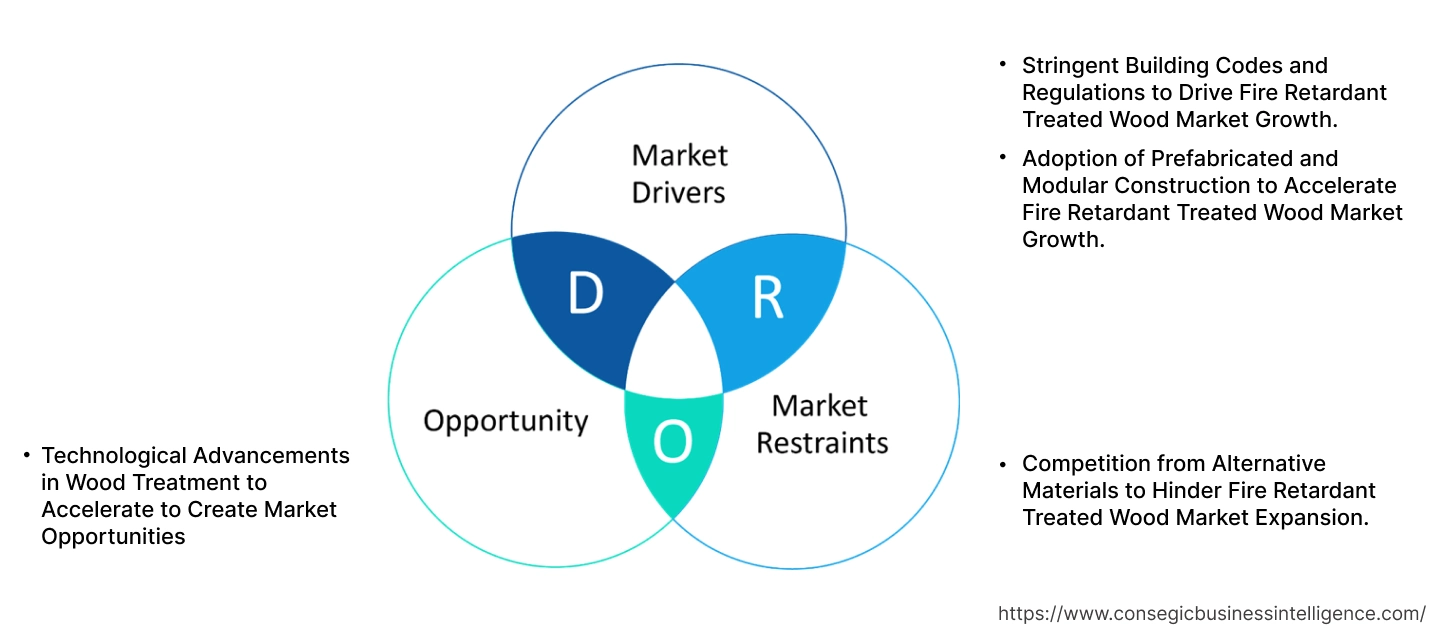Fire Retardant Treated Wood Market Size:
The fire retardant treated wood market size is growing with a CAGR of 4.7% during the forecast period (2025-2032), and the market is projected to be valued at USD 1.88 Billion by 2032 from USD 1.31 Billion in 2024. Additionally, the market value for 2025 is attributed to USD 1.36 Billion.
Fire Retardant Treated Wood Market Scope & Overview:
Fire retardant treated wood (FRTW), also known as fire rated wood, refers to the solid or engineered wood material that has undergone a treatment to improve its fire resistance properties. This type of wood exhibits key benefits including reduced flammability, slowed flame spread, and lower smoke production. This wood finds a spectrum of applications ranging from furniture to critical structural framing, windows and doors, exterior cladding, stairways, and railings, as well as other specialized uses. The end-use sectors for this wood include residential, commercial, industrial, and institutional sectors, reflecting their importance in enhancing fire safety across a diverse range of construction and application areas.
Fire Retardant Treated Wood Market Dynamics - (DRO) :
Key Drivers:
Stringent Building Codes and Regulations to Drive Fire Retardant Treated Wood Market Growth.
As authorities worldwide prioritize fire safety in construction, they are implementing and enforcing stricter mandates that necessitate the use of FRTW in various applications. These regulations often target structural components in specific building types, interior finishes in public spaces, and concealed areas to enhance fire resistance and improve occupant safety. The growing awareness of fire hazards and the potential for substantial loss of life and property have led to this increased regulatory focus.
- For instance, in 2024, according to Lemahieu Group, Germany introduced new regulations regarding fire safety requirements for wood cladding, particularly for lower buildings (under 10 meters). These regulations mandate a specific reaction to fire classification for wood cladding in such buildings.
Consequently, the need for fire rated wood rises as builders, developers, and architects must comply with these mandatory requirements to ensure the safety and legality of their projects. Hence, this regulatory push establishes a consistent and expanding market for manufacturers, making it a crucial driver for market growth on a global scale.
Adoption of Prefabricated and Modular Construction to Accelerate Fire Retardant Treated Wood Market Growth.
Prefabrication and modular construction involve building components or entire modules in a controlled factory environment before on-site assembly. These methods are gaining preference due to their efficiency, cost-effectiveness, and sustainability advantages. Prefabricated and modular buildings must meet the same stringent fire safety standards as traditionally built structures. This necessitates the use of FRTW in wood-based elements to comply with regulations and protect occupants. Additionally, government support encourages the adoption of prefabricated and modular construction.
- For instance, the Canadian government's 2024 Federal Budget introduced a new Homebuilding Technology and Innovation Fund aimed at accelerating the adoption of innovative housing technologies and materials in the country's homebuilding sector. This includes a focus on modular and prefabricated homes.
As a result, as per analysis, the increasing acceptance and adoption of prefabricated and modular construction directly increase the demand for fire rated wood as a crucial material for ensuring fire safety compliance, efficient building practices, and material optimization within this evolving construction sector.
Key Restraints:
Competition from Alternative Materials to Hinder Fire Retardant Treated Wood Market Expansion.
The fire retardant treated wood market demand faces constraints due to the widespread availability of alternative options across its applications. Competition from non-combustible materials such as advanced-strength steel and concrete poses a significant hindrance for the market, particularly in large commercial and industrial projects prioritizing fire resistance and structural integrity under extreme conditions. Intumescent coatings offer a cost-effective alternative for achieving specific fire ratings on various substrates, including untreated wood. Furthermore, the emergence of fire resistant composites present substitutes with a balance of strength, weight, and fire performance. This ready availability and growing commercialization of substitutes create a competitive landscape and support players to adopt alternatives. As a result, the above-mentioned factors are limiting the fire retardant treated wood market expansion.
Future Opportunities :
Technological Advancements in Wood Treatment to Accelerate to Create Market Opportunities.
Advancements are leading to the development of new fire retardant formulations that offer improved performance in terms of flame spread, smoke development, and heat release. These advanced chemicals provide a higher level of fire protection with lower application rates. Furthermore, advancements are improving the durability and longevity of the treatments, ensuring lasting fire resistance. Efforts to reduce the corrosion potential of FRTW chemicals on fasteners and enhance compatibility with adhesives and coatings are also expanding its usability. Innovations are also focused on creating environmentally friendlier treatments, addressing sustainability concerns and regulations.
- For instance, in February 2024, T2EARTH announced the launch of OnWood 1.0 American Cab, the first-ever sustainable, eco-friendly tinted fire retardant treated wood.
Thus, as per the market analysis, these advancements are making wood a more reliable, versatile, and appealing material for a wider range of construction applications, thereby supporting market revenue in forecast years.
Fire Retardant Treated Wood Market Segmental Analysis :
By Wood Type:
Based on wood type, the market is bifurcated into solid wood and engineered wood.
Trends in Wood Type:
- Innovations in fire retardant treatments are enhancing the performance and durability of fire rated engineered wood products.
- There's an increasing trend for FRTW sourced from sustainably managed forests, aligning with the broader green building movement.
The solid wood segment accounted for the largest market share in 2024.
- Solid wood refers to lumber in its natural, solid form that has undergone chemical treatment to enhance its fire resistance.
- Solid wood finds widespread application in structural framing, including essential components such as wall studs, load-bearing walls, partition walls, floor joists, roof rafters, and trusses.
- Beyond primary framing, it is also utilized in sheathing, sub-flooring, beams, and even stairways to enhance fire safety.
- The increasing implementation and enforcement of stringent building codes that mandate the use of solid wood in structural elements is the factor driving the segment revenue.
- Furthermore, growing awareness of potential fire hazards, coupled with the material's ability to maintain structural integrity for an extended period during a fire, significantly contributes to its demand across residential, commercial, and institutional construction projects.
The engineered wood segment is expected to grow at the fastest CAGR over the forecast period.
- Engineered wood encompasses material manufactured by binding together wood strands, fibers, veneers, or other forms of wood with adhesives to form composite materials.
- It encompasses wood types such as plywood, oriented strand board (OSB), laminated veneer lumber (LVL), and glued laminated timber (glulam) that have been treated with fire retardants.
- Engineered wood products offer specific performance characteristics and dimensional stability, and their treatment enhances their fire safety for various applications.
- Additionally, the growing focus on the development of environmentally friendly fire rated engineered wood is expected to boost segment revenue.
- As per the analysis, owing to the aforementioned factors, the engineered wood segment is expected to grow at the fastest CAGR in the fire retardant treated wood market demand.
By Application:
Based on application, the market is categorized into furniture, structural framing, roofing & flooring, windows & doors, cladding & facades, stairways & railings, and others.
Trends in the Application:
- In areas susceptible to wildfires, fire rated wood framing and sheathing are increasingly being specified for exterior walls to enhance the building's resistance to ignition from external fire sources.
- A rising trend is the use of fire rated engineered wood products in structural framing due to their enhanced strength, dimensional stability, and fire resistance properties.
The structural framing segment accounted for the largest fire retardant treated wood market share in 2024.
- Fire retardant treated wood is crucial in structural framing, encompassing vital elements such as wall studs and sheathing, load bearing, and partition walls.
- In floor systems, it's used for joists, sub-flooring, and sill plates, alongside blocking and furring. Roof structures benefit from FRTW in rafters, trusses, and sheathing, as well as ceiling joists.
- Essential horizontal supports including beams and headers also utilize fire rated wood.
- Moreover, structural components of stairways and framing utilize this wood high-traffic areas.
- The demand for fire rated wood in these structural applications is primarily driven by the increasing focus on stringent global building codes and a heightened awareness of fire safety among builders and occupants. This emphasizes the need for materials that slow fire spread and maintain structural integrity.
- Consequently, the structural framing segment functions as the principal determinant of dynamics within the fire retardant treated wood market trend.
The windows & doors segment is expected to grow at the fastest CAGR over the forecast period.
- Fire rated wood plays a vital role in enhancing the fire safety of windows and doors, particularly in fire rated assemblies.
- It finds applications in window and door frames, door cores, glazing beads, and even exterior doors in wildfire prone areas.
- This adoption is primarily driven by stringent building codes mandating fire rated openings for compartmentalization, maintaining the fire resistance of wall assemblies, and safeguarding exit routes.
- The adoption is further fueled by the need for aesthetically appealing fire rated solutions, the integration of fire rated doors with fire resistant glazing, its durability, and the increasing need for retrofitting existing buildings to meet evolving safety standards and address wildfire risks.
- Hence, owing to the above-mentioned analysis, the windows & doors segment is expected to grow at the fastest rate over the future years, creating fire retardant treated wood market opportunities.
By End Use:
The end use segment is categorized into residential, commercial, industrial, and institutional.
Trends in the End Use:
- Growing home renovation and remodeling is a trend positively impacting the market.
- Integration of fire retardant treated wood with green building initiatives is supporting the market.
The residential segment accounted for the fire retardant treated wood market share of 53.66% in 2024.
- The residential segment involves the use of fire rated wood in single-family homes, multi-family dwellings, and apartments.
- In residential settings, fire treated wood is utilized in a wide range of applications including structural framing, flooring & roofing, sheathing, decking, furniture, and architectural services such as interior designing among others to enhance fire safety for occupants.
- Growing awareness of home safety and increasing new construction and renovations drive the segment revenue.
- Thus, as per the fire retardant treated wood market analysis, the residential segment is dominating the market.
The commercial segment is expected to grow at the fastest CAGR over the forecast period.
- The commercial sector encompasses the use of wood treated with fire retardants in non-residential buildings such as offices, retail spaces, hotels, restaurants, and entertainment venues.
- In the commercial sector, fire rated wood is used in several applications including structural components, wall systems, flooring such as laminated flooring, roofing, and interior finishes among others often mandated by stringent building codes to ensure the safety of a larger number of occupants and protect assets.
- Commercial property owners and developers are prioritizing safety to mitigate liability risks associated with fire incidents, in turn contributing to the fire retardant treated wood market trends.
- As fire safety standards evolve, there's a growing need to renovate and retrofit older commercial buildings with fire resistant materials, further supporting the growth of commercial end use in the forecast period.

Regional Analysis:
The regional segment includes North America, Europe, Asia Pacific, the Middle East and Africa, and Latin America.

In 2024, North America accounted for the highest market share at 38.77% and was valued at USD 0.51 Billion and is expected to reach USD 0.68 Billion in 2032. In North America, the U.S. accounted for a market share of 71.23% during the base year of 2024. North America’s influence on the market is significant with U.S. and Canada being key contributors. Several factors drive this market, including stringent fire safety regulations and building codes for both residential and commercial construction. The widespread availability of advanced fire retardant treatments and the adoption of prefabricated and modular construction sectors also contribute to the market share across the region.
- For instance, in 2024, Module-T Prefabrik announced its entry into the U.S. market. The company announced the introduction of a comprehensive suite of modular solutions, such as office containers, dormitory blocks, and modular office buildings.
These factors create a strong upward trajectory for the North American market, positioning it as a key region for players.

In Asia Pacific, the fire retardant treated wood industry is experiencing the fastest growth with a CAGR of 6.2% over the forecast period. The market revenue across the region is propelled by the strong construction sector and expanding infrastructure projects. Countries such as China and India are key players in this growth. Expanding infrastructure projects along with government initiatives to improve fire safety standards, and a rising awareness of fire safety are expected to propel the market. These factors collectively present a positive impact on the Asia Pacific fire retardant-treated wood market opportunities.
The European fire rated wood industry is significantly defined by the stringent fire safety regulations and the increasing demand for sustainable building materials. Countries within the European Union have implemented fire safety standards for construction materials, which contributes to the growth of the FRTW market. Additionally, increasing awareness of the environmental benefits of wood, coupled with concerns about fire safety, is driving the demand for fire rated wood in Europe.
One of the Latin American fire retardant treated wood industry trend is the region's focus on infrastructure development. The growing investments in infrastructure, particularly in countries such as Brazil, contribute significantly to this requirement for fire rated wood in several applications in residential, commercial, and industrial buildings. Furthermore, the increasing disposable incomes and a growing awareness of fire safety are boosting the need for this wood in the region. As per analysis, these aforementioned factors are contributing to the upward trajectory of the market.
The Middle East and African fire retardant treated wood market analysis is currently characterized by a growing focus on infrastructure development. This has led to significant growth potential for the market in the upcoming years. Increasing investments in the construction sector, particularly large-scale institutional and commercial construction projects in countries like the UAE, Saudi Arabia, and Qatar are expected to positively influence the adoption of fire rated wood to improve safety.
Top Key Players and Market Share Insights:
The Global Fire Retardant Treated Wood Market is highly competitive with major players providing products to the national and international markets. Key players are adopting several strategies in research and development (R&D) and product innovation to hold a strong position in the global Fire Retardant Treated Wood market. Key players in the Fire Retardant Treated Wood industry include
- FLAMEPROOF (U.S.)
- T2EARTH, LLC. (U.S.)
- Hoover Treated Wood Products, Inc. (U.S.)
- ProWood (U.S.)
- Woodsafe Timber Protection AB (Sweden)
Recent Industry Developments :
Facility Expansion:
- In April 2025, T2EARTH introduced OnWood Plywood, a cutting-edge, eco-friendly FRTW that is free of toxic chemicals. This innovative plywood offers superior strength, a Class A fire safety rating, and sustainable design, presenting builders and developers with a healthier, higher-performing, and cost-effective option for construction in fire prone areas.
Fire Retardant Treated Wood Market Report Insights :
| Report Attributes | Report Details |
| Study Timeline | 2019-2032 |
| Market Size in 2032 | USD 1.88 Billion |
| CAGR (2025-2032) | 4.7% |
| By Wood Type |
|
| By Application |
|
| By End Use |
|
| By Region |
|
| Key Players |
|
| North America | U.S. Canada Mexico |
| Europe | U.K. Germany France Spain Italy Russia Benelux Rest of Europe |
| APAC | China South Korea Japan India Australia ASEAN Rest of Asia-Pacific |
| Middle East and Africa | GCC Turkey South Africa Rest of MEA |
| LATAM | Brazil Argentina Chile Rest of LATAM |
| Report Coverage |
|
Key Questions Answered in the Report
How big is the Fire Retardant Treated Wood market? +
In 2024, the Fire Retardant Treated Wood market is USD 1.31 Billion.
Which is the fastest-growing region in the Fire Retardant Treated Wood market? +
Asia Pacific is the fastest-growing region in the Fire Retardant Treated Wood market.
What specific segmentation details are covered in the Fire Retardant Treated Wood market? +
By Wood Type, By Application and End Use segmentation details are covered in the Fire Retardant Treated Wood market.
Who are the major players in the Fire Retardant Treated Wood market? +
Viance (U.S.), Doman (Canada), FLAMEPROOF (U.S.), T2EARTH, LLC. (U.S.) are some of the major players in the market.


